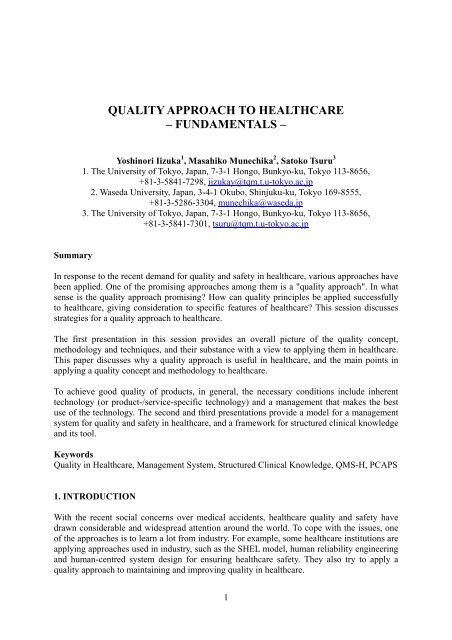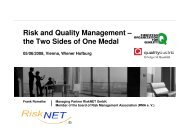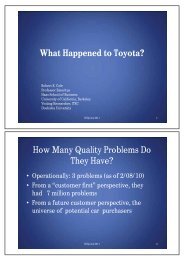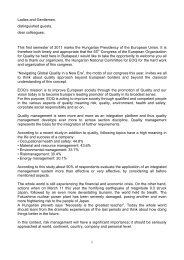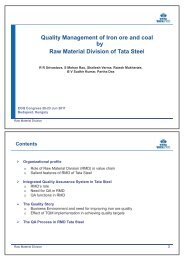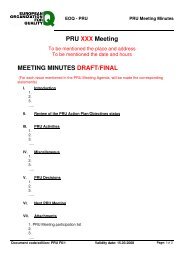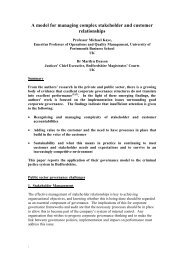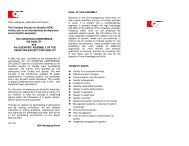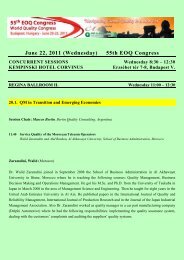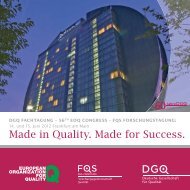quality approach to healthcare – fundamentals - European ...
quality approach to healthcare – fundamentals - European ...
quality approach to healthcare – fundamentals - European ...
Create successful ePaper yourself
Turn your PDF publications into a flip-book with our unique Google optimized e-Paper software.
Summary<br />
QUALITY APPROACH TO HEALTHCARE<br />
<strong>–</strong> FUNDAMENTALS <strong>–</strong><br />
Yoshinori Iizuka 1 , Masahiko Munechika 2 , Sa<strong>to</strong>ko Tsuru 3<br />
1. The University of Tokyo, Japan, 7-3-1 Hongo, Bunkyo-ku, Tokyo 113-8656,<br />
+81-3-5841-7298, iizukay@tqm.t.u-<strong>to</strong>kyo.ac.jp<br />
2. Waseda University, Japan, 3-4-1 Okubo, Shinjuku-ku, Tokyo 169-8555,<br />
+81-3-5286-3304, munechika@waseda.jp<br />
3. The University of Tokyo, Japan, 7-3-1 Hongo, Bunkyo-ku, Tokyo 113-8656,<br />
+81-3-5841-7301, tsuru@tqm.t.u-<strong>to</strong>kyo.ac.jp<br />
In response <strong>to</strong> the recent demand for <strong>quality</strong> and safety in <strong>healthcare</strong>, various <strong>approach</strong>es have<br />
been applied. One of the promising <strong>approach</strong>es among them is a "<strong>quality</strong> <strong>approach</strong>". In what<br />
sense is the <strong>quality</strong> <strong>approach</strong> promising? How can <strong>quality</strong> principles be applied successfully<br />
<strong>to</strong> <strong>healthcare</strong>, giving consideration <strong>to</strong> specific features of <strong>healthcare</strong>? This session discusses<br />
strategies for a <strong>quality</strong> <strong>approach</strong> <strong>to</strong> <strong>healthcare</strong>.<br />
The first presentation in this session provides an overall picture of the <strong>quality</strong> concept,<br />
methodology and techniques, and their substance with a view <strong>to</strong> applying them in <strong>healthcare</strong>.<br />
This paper discusses why a <strong>quality</strong> <strong>approach</strong> is useful in <strong>healthcare</strong>, and the main points in<br />
applying a <strong>quality</strong> concept and methodology <strong>to</strong> <strong>healthcare</strong>.<br />
To achieve good <strong>quality</strong> of products, in general, the necessary conditions include inherent<br />
technology (or product-/service-specific technology) and a management that makes the best<br />
use of the technology. The second and third presentations provide a model for a management<br />
system for <strong>quality</strong> and safety in <strong>healthcare</strong>, and a framework for structured clinical knowledge<br />
and its <strong>to</strong>ol.<br />
Keywords<br />
Quality in Healthcare, Management System, Structured Clinical Knowledge, QMS-H, PCAPS<br />
1. INTRODUCTION<br />
With the recent social concerns over medical accidents, <strong>healthcare</strong> <strong>quality</strong> and safety have<br />
drawn considerable and widespread attention around the world. To cope with the issues, one<br />
of the <strong>approach</strong>es is <strong>to</strong> learn a lot from industry. For example, some <strong>healthcare</strong> institutions are<br />
applying <strong>approach</strong>es used in industry, such as the SHEL model, human reliability engineering<br />
and human-centred system design for ensuring <strong>healthcare</strong> safety. They also try <strong>to</strong> apply a<br />
<strong>quality</strong> <strong>approach</strong> <strong>to</strong> maintaining and improving <strong>quality</strong> in <strong>healthcare</strong>.<br />
1
There can be a variety of <strong>approach</strong>es <strong>to</strong> ensuring <strong>quality</strong> and safety in <strong>healthcare</strong>. One of the<br />
promising ones is the application of <strong>quality</strong> management, or TQM (Total Quality<br />
Management), which has achieved great success in industry, in <strong>healthcare</strong>.<br />
However, there can be a question: Is an <strong>approach</strong> that has been successfully applied in<br />
industry also effective in <strong>healthcare</strong>? Will the <strong>quality</strong> of <strong>healthcare</strong> really be improved through<br />
a <strong>quality</strong> <strong>approach</strong>? Will the management of <strong>healthcare</strong> institutions become sound? Will the<br />
<strong>healthcare</strong> social system become healthy?<br />
In order <strong>to</strong> apply a <strong>quality</strong> <strong>approach</strong> successfully in <strong>healthcare</strong> as well, we have <strong>to</strong> understand<br />
the substance of the concept and methodology of a <strong>quality</strong> <strong>approach</strong> and specific features of<br />
<strong>healthcare</strong> processes, and study how <strong>to</strong> apply the essence of a <strong>quality</strong> <strong>approach</strong> <strong>to</strong> <strong>healthcare</strong>.<br />
2. QUALITY APPROACH<br />
It is quite difficult <strong>to</strong> express the essence of TQM in short words. TQM includes various<br />
profound concepts, thoughts and philosophies that have been established in the process of its<br />
development. It also has excellent methodologies, <strong>to</strong>ols and techniques that are results of the<br />
blood, sweat and tears of great predecessors.<br />
Without minor details, TQM can be characterized as “an <strong>approach</strong> <strong>to</strong> management, putting<br />
<strong>quality</strong> at its core, and putting importance on continual improvement participated in by<br />
everyone”. In other words, TQM can be condensed in<strong>to</strong> three essentials: “<strong>quality</strong>”,<br />
“participation by everyone”, and “improvement (KAIZEN)”. These concepts are unique <strong>to</strong><br />
TQM, as other systematic management improvement methods do not include them explicitly.<br />
TQM has been effective in improving management systems in an organized manner.<br />
TQM has repeatedly pointed out the importance of <strong>quality</strong> in business management.<br />
Companies survive on payment from their cus<strong>to</strong>mers for the products and services they<br />
provide. Companies cannot go very far unless cus<strong>to</strong>mers are willing <strong>to</strong> buy their products and<br />
services. As companies need <strong>to</strong> satisfy their cus<strong>to</strong>mers not for a short time, but for a long time,<br />
<strong>quality</strong>, including price, of their products and services is important. Quality has always meant<br />
“cus<strong>to</strong>mer acceptance” and “cus<strong>to</strong>mer-orientation”, and has been an integral part of the TQM<br />
philosophy from the beginning.<br />
To achieve <strong>quality</strong>, TQM encourages participation by everyone. When the product and service<br />
<strong>quality</strong> of a company is recognized as a reflection of the aggregate <strong>quality</strong> characteristics of<br />
that organization, it becomes obvious that the involvement of everyone is not only necessary<br />
but also efficient for achieving <strong>quality</strong>. In this regard, TQM has advocated efforts <strong>to</strong> uplift<br />
people through education and training, morale enhancement, and proper feedback<br />
mechanisms <strong>to</strong> their consequent work.<br />
Unless a system has a built-in subsystem <strong>to</strong> improve itself, it is not a good system. TQM<br />
emphasizes problem-solving. It emphasizes the importance of continual improvement of<br />
products, processes, and systems, but not in dwelling on past failures. This is based on the<br />
notion that technologies and management systems can never be perfect, and thus require<br />
constant efforts <strong>to</strong> improve. TQM encourages such efforts through participation by everyone.<br />
The concepts, methodologies and techniques of TQM have been established through a variety<br />
2
of practices in industry for more than 50 years, and can be condensed in<strong>to</strong> the three key words<br />
mentioned above. The overall picture of TQM is indeed wide and deep, consisting of a variety<br />
of elements, including fundamental concepts, management system model, <strong>to</strong>ols and<br />
techniques, and promotion techniques as shown in Table 1.<br />
Table 1 <strong>–</strong> TQM Elements<br />
(1) Fundamental concepts<br />
• Quality, Management, and People<br />
(2) Management system model<br />
• Top management’s leadership, Vision, and Strategy<br />
• Management systems: Administration of management systems,<br />
Daily management, Management by policy<br />
• Quality Assurance System: QA systems, QA system elements, harmonization with<br />
ISO 9000<br />
• Cross-functional management: Cost management, Volume and Delivery<br />
management, Environment management, Safety management, etc.<br />
• Resource management: People, information, knowledge, technology, etc.<br />
(3) Tools and Techniques<br />
• Scientific problem-solving <strong>approach</strong><br />
• Statistical techniques, Seven basic QC <strong>to</strong>ols (Q7), Seven management <strong>to</strong>ols (N7)<br />
• Product-planning seven <strong>to</strong>ols (P7), Strategic-planning seven <strong>to</strong>ols (S7)<br />
• Quality function deployment (QFD), Failure Mode and Effect Analysis, Fault Tree<br />
Analysis, Design Reviews, Reliability Engineering<br />
• Other management <strong>to</strong>ols<br />
(4) Promotion techniques<br />
• Introduction and promotion: Standard steps, organization, training, assessment,<br />
diagnosis<br />
• Enhancing people and organization’s ability: Level-up of individuals and department,<br />
recognition<br />
• Mutual enlightenment, information-sharing: Nation-wide promotion, opportunity for<br />
mutual enlightenment, Bench-marking<br />
3. QUALITY IN MANAGEMENT<br />
It is considered that the primary purpose of the management of an organization is <strong>to</strong> provide<br />
value <strong>to</strong> cus<strong>to</strong>mers through its products and services. The profit obtained is <strong>to</strong> be used for<br />
rotating a reproducible cycle of cus<strong>to</strong>mer value provision. Quality is generally defined as “a<br />
<strong>to</strong>tality of characteristics of an entity that bears on its needs and expectations”. As the<br />
cus<strong>to</strong>mers have needs and expectations, <strong>quality</strong> is regarded as the evaluation of the value<br />
provided through products and services from cus<strong>to</strong>mer viewpoints. Then, <strong>quality</strong> is the<br />
primary and direct purpose of the management of an organization.<br />
On the contrary, in general, most people say the purpose of management is profit. For the sake<br />
of profit, however, it is essential <strong>to</strong> enhance the <strong>quality</strong> of products and services as cus<strong>to</strong>mer<br />
satisfaction <strong>to</strong> increase sales. Giving consideration that the purpose of establishing an<br />
organization is <strong>to</strong> provide value <strong>to</strong> society and cus<strong>to</strong>mers, profit should be regarded as a<br />
3
measure <strong>to</strong> keep providing value <strong>to</strong> the cus<strong>to</strong>mer and the result of cus<strong>to</strong>mer acceptance, rather<br />
than the purpose of management.<br />
Management System<br />
Organization<br />
Management<br />
Quality<br />
Management<br />
System<br />
4<br />
Products<br />
Services<br />
Quality<br />
Cus<strong>to</strong>mer<br />
Quality of products/services<br />
= Products/services accepted by cus<strong>to</strong>mers<br />
= Basis for success in business management<br />
Purpose of an organization: Cus<strong>to</strong>mer value provision through products<br />
Purpose of its management: Provision of good <strong>quality</strong> of products<br />
Profit: Source for reproducible c ycle for cus<strong>to</strong>mer value provision<br />
Figure 1 <strong>–</strong> Quality in Management<br />
If we define <strong>quality</strong> management as “management focusing on maintaining and enhancing<br />
cus<strong>to</strong>mer evaluation of the value that is provided through products and services”, namely<br />
“management for <strong>quality</strong>”, <strong>quality</strong> management will be a management <strong>to</strong>ol covering a wide<br />
range of general management.<br />
There are two important leading principles in <strong>quality</strong> management. One is “<strong>quality</strong>-centred”<br />
and the other is “systems orientation”. Quality management pays attention <strong>to</strong> “<strong>quality</strong>”.<br />
Quality is essential in comparison with cost, volume, efficiency and others. To achieve <strong>quality</strong>,<br />
<strong>quality</strong> management focuses on systems, or processes and resources. In other words, it<br />
focuses on fac<strong>to</strong>rs affecting the results. This is a general principle for effective and efficient<br />
management.<br />
A well-organized way of “managing for <strong>quality</strong>” will function as follows:<br />
• An organization is established <strong>to</strong> provide value <strong>to</strong> cus<strong>to</strong>mers.<br />
• The value is provided <strong>to</strong> cus<strong>to</strong>mers through products and services.<br />
• Quality management focuses management systems on ensuring <strong>quality</strong>.<br />
• The management system will be a comprehensive one.<br />
• This will result in improving brand value and financial results.<br />
Then, the fundamental scheme of <strong>quality</strong> management can be described as follows:<br />
Systems (Processes + Resources) Cus<strong>to</strong>mer satisfaction Financial results<br />
4. APPLICATION OF QUALITY APPROACH TO HEALTHCARE<br />
Based on the understanding of <strong>quality</strong> management, there can be three viewpoints, as in the
following.<br />
(1) Understanding the fundamental concept of a <strong>quality</strong> <strong>approach</strong> and its implementation<br />
• Quality: Cus<strong>to</strong>mer satisfaction<br />
• Management: All activities <strong>to</strong> achieve objectives<br />
(2) Establishing Healthcare Quality Management Systems (QMS)<br />
• Management: Technology <strong>to</strong> make use of inherent technology<br />
• QMS: Management system for <strong>quality</strong>, definition of work processes<br />
(3) Visualizing, structuring and standardizing clinical knowledge<br />
• Visualization of technology and knowledge necessary in clinical processes<br />
• Structuring of technology and knowledge based on substances and characteristics of<br />
<strong>healthcare</strong><br />
• Standardization as a means of sharing best practices (application of better ways)<br />
5. QUALITY<br />
Quality is defined as “degree of satisfaction of cus<strong>to</strong>mers/users” or “fitness for use”. The<br />
essential point is that <strong>quality</strong> is determined by the cus<strong>to</strong>mers’ evaluation, and not by the<br />
provider’s criteria.<br />
My favourite definition of <strong>quality</strong> is “a <strong>to</strong>tality of characteristics of an entity that bears on its<br />
needs and expectations”. Anyway, <strong>quality</strong> is a <strong>to</strong>tality of characteristics of an entity. The main<br />
point in this definition is in the clause “that bears on its needs and expectations”. As those<br />
who have needs are cus<strong>to</strong>mers, it is reasonable that the core concept of <strong>quality</strong> is cus<strong>to</strong>mer<br />
orientation and cus<strong>to</strong>mer focus. Also, <strong>quality</strong> can be considered with regard <strong>to</strong> anything,<br />
including product, service, system, people, process, project, task, work, management,<br />
organization, etc.<br />
In addition, this definition leads <strong>to</strong> a profound meaning of <strong>quality</strong>, i.e. the purpose-oriented<br />
way of thinking and doing. The core concept of <strong>quality</strong> is cus<strong>to</strong>mer-oriented. That is <strong>to</strong> say,<br />
the <strong>quality</strong> concept puts importance on external criteria, but not on internal criteria from the<br />
supplier’s viewpoint. That is, it is purpose-oriented. This is why methods in <strong>quality</strong><br />
management can be applied in any category of issues. Methods <strong>to</strong> achieve <strong>quality</strong> are, in other<br />
words, methods <strong>to</strong> achieve objectives. Then, once an issue is well defined, the issue in any<br />
field can be resolved using methods of <strong>quality</strong> management.<br />
In <strong>quality</strong> management, there is an interesting lesson included; the next processes are our<br />
cus<strong>to</strong>mers. This lesson was originally developed in Japan in the 1950’s. In order <strong>to</strong> achieve<br />
<strong>quality</strong> for cus<strong>to</strong>mers/users economically and efficiently, each process should:<br />
• Define the <strong>quality</strong> of its own process (value provided <strong>to</strong> next processes),<br />
• Determine proper measures for providing the value,<br />
• Implement them and give satisfaction.<br />
If this thought is unders<strong>to</strong>od and realized, all people realize their roles and responsibility<br />
within the whole organization, and identify the objectives of their own job and perform their<br />
job successfully. This incredible way of thinking and doing has resulted in two wonderful<br />
concepts: “internal cus<strong>to</strong>mer” and “process owner”. In the context of “internal cus<strong>to</strong>mer”,<br />
everyone regards all people who are affected by the performance of their own job as<br />
cus<strong>to</strong>mers and assures the <strong>quality</strong> of their own job. Also, the concept of “process owner”<br />
5
encourages everyone <strong>to</strong> understand the significance and importance of their own job in<br />
relation <strong>to</strong> the purpose of the organization, do their duty, take pride in their job, and assure the<br />
<strong>quality</strong> of their own job.<br />
6. MANAGEMENT<br />
Management, in the context of <strong>quality</strong> management, is defined as “all activities <strong>to</strong> achieve<br />
objectives continually and efficiently”. The main point of this definition is, of course,<br />
achievement of objectives. For a sound management, four functions are necessary, as shown<br />
in Figure 2.<br />
Plan (1) Determine objectives<br />
(2) Define control items<br />
(3) Set target (control level)<br />
(4) Determine procedure<br />
Do (1) Perform training<br />
(2) Do as in the procedure<br />
Check (1) The target achieved?<br />
(2) Any other nonconformities?<br />
(Undesirable side effects?)<br />
Act (1) Immediate remedy:<br />
remove nonconformity<br />
(2) Recurrence prevention:<br />
remove causes<br />
6<br />
Act<br />
Figure 2 <strong>–</strong> PDCA: Management cycle<br />
Plan<br />
Check Do<br />
In management, standardization is crucial. Standardization is a unification and simplification<br />
for the sake of impartial benefit and usefulness among interested parties. Still, standardization<br />
is frequently misunders<strong>to</strong>od as improper uniformity.<br />
A standard is a plan for the continual achievement of objectives. In Figure 2, item (4) of<br />
“plan” indicates “procedure”. In fact, “plan” consists of two parts; one is objectives, and the<br />
other is measures <strong>to</strong> achieve the objectives. If these objectives are set out repeatedly, almost<br />
the same measures will be determined <strong>to</strong> achieve these objectives. These measures will be<br />
standardized as a procedure.<br />
Standardization is a measure <strong>to</strong> reuse knowledge. There are two types of standards. One is a<br />
standard that must be determined <strong>to</strong> prevent confusion by adopting uniformity. One example<br />
is a signal; the blue is <strong>to</strong> go and the red is <strong>to</strong> s<strong>to</strong>p. Either is OK, but these must be determined<br />
in whatever way. The other type is a standard that had better be determined. This is a reuse of<br />
experiences and simplification of planning. This type of standard is defined as “a thing or<br />
method that has been found <strong>to</strong> be good based on experience”. Standardization is really a reuse<br />
of knowledge, effective use of experience, a method <strong>to</strong> save thinking, and a measure <strong>to</strong> share<br />
best practices.
The purpose of standardization is <strong>to</strong> save thinking in preparing implementation plans that are<br />
repeated, and <strong>to</strong> apply a proper method that has been demonstrated as being good. In this<br />
sense, standardization is a basis for improvement. For effective improvement, it is necessary<br />
<strong>to</strong> determine a current method, identify the causes of a problem, if any, in the method, and<br />
revise the method for the improvement. Standardization is also a basis for originality. One of<br />
the key points for a successful job is <strong>to</strong> focus on new, difficult and important things. To make<br />
this possible, the best way is not <strong>to</strong> spend time thinking about what is already known how <strong>to</strong><br />
do, but <strong>to</strong> reuse a good thing that has been found <strong>to</strong> be good.<br />
Management principles in <strong>quality</strong> management teach “building <strong>quality</strong> in the process” or<br />
“process control”. To obtain good results, it is better <strong>to</strong> focus on processes that produce the<br />
results and <strong>to</strong> control the processes. To do this, it is necessary <strong>to</strong> identify relationships<br />
between the results and process fac<strong>to</strong>rs, standardize the process fac<strong>to</strong>rs, and perform work<br />
following the standard procedures. And, when the results are not desirable, the relevant<br />
process conditions are <strong>to</strong> be revised for improvement.<br />
In the PDCA of the management cycle, <strong>quality</strong> management stresses the importance of “A:<br />
Act”. It distinguishes three types of actions: immediate remedy, recurrence prevention and<br />
preventive actions. Immediate remedy removes, in principle, an undesirable situation or<br />
symp<strong>to</strong>m, while recurrence prevention removes the causes of the undesirable symp<strong>to</strong>ms. To<br />
make this possible, it is necessary <strong>to</strong> identify the real causes that brought out the symp<strong>to</strong>ms,<br />
through the process of deep analysis. For preventive actions, it is necessary <strong>to</strong> extract essential<br />
knowledge from experience.<br />
7. HEALTHCARE QUALITY MANAGEMENT SYSTEM<br />
To achieve <strong>quality</strong> of product and services, in general, it is necessary <strong>to</strong> have two conditions:<br />
• Inherent technology, or product-/service-specific technology, and<br />
• Management systems <strong>to</strong> utilize the inherent technology as a whole organization.<br />
A methodology related <strong>to</strong> the second one is called “management technology”, which is a<br />
technology or methodology <strong>to</strong> make the best use of inherent technology. Of course, the<br />
inherent technology is more important than management technology, but management<br />
technology must not be slighted. A typical management technology is a procedure, manual,<br />
instruction, guidelines, templates, and worksheets. They specify and recommend the measures<br />
necessary <strong>to</strong> achieve objectives. The representation of the technical contents necessary <strong>to</strong><br />
achieve objectives, i.e. inherent technology, is also essential, as a management technology, <strong>to</strong><br />
support an application of proper inherent technology.<br />
These management technologies should be established in a well-organized manner as the<br />
management system of an organization. To ensure <strong>quality</strong> and safety in <strong>healthcare</strong>, a <strong>quality</strong><br />
management system should be established and implemented. Dr. Masahiko Munechika<br />
presents a model for a <strong>quality</strong> management system for <strong>healthcare</strong> and reports on joint research<br />
done with hospitals, which introduces and promotes <strong>healthcare</strong> <strong>quality</strong> management systems.<br />
8. STRUCTURING CLINICAL KNOWLEDGE<br />
As mentioned above, the inherent technology is essential for <strong>quality</strong> of products and services.<br />
7
Actually, the level of any management system cannot exceed the level of the inherent<br />
technology which is embedded in the management system. And, for the effective management<br />
system, the level of visualization, structuration and systematization of the inherent technology<br />
is essential, as well as the contents of the inherent technology.<br />
Also, in <strong>healthcare</strong>, clinical knowledge is crucial in clinical processes. For the effective<br />
<strong>healthcare</strong> <strong>quality</strong> management system, it is necessary <strong>to</strong> establish a body of knowledge and<br />
technology basis necessary <strong>to</strong> ensure the <strong>quality</strong> of <strong>healthcare</strong> processes. In addition, a<br />
methodology is necessary <strong>to</strong> fully utilize inherent technology which has already been<br />
established. We should have systematization of clinical knowledge in suitable structures,<br />
taking in<strong>to</strong> account the specific features of <strong>healthcare</strong> processes.<br />
Dr. Sa<strong>to</strong>ko Tsuru proposes PCAPS (Patient Condition Adaptive Path System), which is a<br />
representation of a body of knowledge for clinical processes in a form of <strong>healthcare</strong><br />
intervention adaptive <strong>to</strong> patient condition.<br />
9. QUALITY MANAGEMENT AS A MOVEMENT FOR ORGANIZATIONAL<br />
IMPROVEMENT<br />
A <strong>quality</strong> <strong>approach</strong> can be one of the best management <strong>to</strong>ols for organizational improvement<br />
and innovation, because <strong>quality</strong> management is a management <strong>to</strong>ol <strong>to</strong> enhance the value the<br />
organization provides <strong>to</strong> its cus<strong>to</strong>mers by focusing on management systems as well as<br />
inherent technology. It will upgrade organizational capability in providing value <strong>to</strong> the<br />
cus<strong>to</strong>mer, a basis for long-term success. In this sense, a <strong>quality</strong> management system should be<br />
read as “a management system for cus<strong>to</strong>mer value provision”.<br />
A <strong>quality</strong> <strong>approach</strong> will make people and organizations wise. What is meant by “wise”?<br />
“Being wise” has the following meanings;<br />
• Purpose: Can understand purposes/objectives, Follow purpose-/objective-oriented way<br />
of thinking and doing<br />
• Cause: Consider cause-and-effect relationship, Think about purpose-and-means<br />
relationship, Know methods <strong>to</strong> identify these relationships<br />
• Essence: Can extract and grasp essences from things, Can apply essences <strong>to</strong> various<br />
things, Have a good sense of generalization and abstraction<br />
• Reflection: Can rotate PDCA cycle appropriately, Can perform deep analysis, Can<br />
conceive broader range of recurrence prevention, Can predict and prevent<br />
As described in previous sections, a <strong>quality</strong> <strong>approach</strong> has the following features;<br />
• Quality concept: Purpose-oriented<br />
• Methodology: Cause-and-effect relations, Purpose-and-means relations<br />
• True causes, common causes: Deepest analysis, Generalization, Horizontal deployment<br />
• Actions: Recurrence prevention, Preventive actions<br />
People who learn the <strong>quality</strong> concept and methodology will become wiser if they understand<br />
the essence of the <strong>quality</strong> <strong>approach</strong>. Also, an organization which introduces and promotes the<br />
<strong>quality</strong> concept and methodology in a sincere manner will upgrade its management level and<br />
become wiser as a whole organization.<br />
8
Quality management is also useful in <strong>healthcare</strong>, if applied giving consideration <strong>to</strong> the<br />
features of <strong>healthcare</strong> processes.<br />
9
Quality Management<br />
Approach <strong>to</strong> Healthcare<br />
Yoshinori Iizuka<br />
Masahiko Munechika<br />
Sa<strong>to</strong>ko Tsuru
Quality Management Approach <strong>to</strong> Healthcare<br />
1. Quality Approach <strong>to</strong> Healthcare <strong>–</strong> Fundamentals (25’)<br />
Yoshinori Iizuka, The University of Tokyo<br />
2. A Model for Healthcare Quality Management <strong>–</strong> QMS-H (20’)<br />
Masahiko Munechika, Waseda University<br />
3. A Framework for Structured Clinical Knowledge <strong>–</strong> PCAPS (20’)<br />
Sa<strong>to</strong>ko Tsuru, The University of Tokyo<br />
4. General Discussion (20’)<br />
Masahiko Munechika Sa<strong>to</strong>ko Tsuru Yoshinori Iizuka<br />
2
Quality Approach <strong>to</strong> Healthcare<br />
<strong>–</strong> Fundamentals <strong>–</strong><br />
Yoshinori Iizuka<br />
The University of Tokyo
Quality Approach <strong>to</strong> Healthcare<br />
Attention <strong>to</strong> <strong>healthcare</strong> <strong>quality</strong> and safety<br />
Approaches for safety applied in industry (e.g. SHEL model,<br />
human reliability engineering and human centered system<br />
design)<br />
Quality <strong>approach</strong> (e.g. TQM: Total Quality Management)<br />
successfully applied in industry<br />
An <strong>approach</strong> successfully applied in industry also<br />
effective in <strong>healthcare</strong>?<br />
Quality of <strong>healthcare</strong> really be improved?<br />
Management of <strong>healthcare</strong> institutions become sound?<br />
Healthcare social system become healthy?<br />
4
What is TQC/TQM?<br />
Quality<br />
Importance of <strong>quality</strong> in business management: “<strong>quality</strong>” is a<br />
source of long-term profit<br />
Quality losses: Variety of losses due <strong>to</strong> poor <strong>quality</strong><br />
Quality problems that do not look <strong>quality</strong> problems: cost<br />
problems, delivery time problems, ……<br />
Participation by all people<br />
Participation by all members of the organization: “<strong>quality</strong>” can<br />
be achieved by contribution of all personnel<br />
Upgrading people’s competence: <strong>quality</strong> of people<br />
Improvement (KAIZEN)<br />
Continually upgrading oneself in “technology” (reproducible<br />
methodology) and “management” (organizations<br />
mechanisms <strong>to</strong> make the best use of technology)<br />
5
TQM Elements<br />
(1) Fundamental concepts<br />
Quality, Management, and People<br />
(2) Management systems model<br />
Top management’s Leadership, Vision, and Strategy<br />
Management systems: Administration of management<br />
systems, Daily management, Management by policy<br />
Quality Assurance System: QA systems, QA system<br />
elements, Harmonization with ISO 9000<br />
Cross-functional management: Cost management, Volume<br />
and Delivery management, Environment management,<br />
Safety management, etc.<br />
Resource management: People, Information, Knowledge,<br />
Technology, etc.<br />
6
TQM Elements<br />
(3) Tools and Techniques<br />
Statistical techniques, Seven basic QC <strong>to</strong>ols (Q7), Seven<br />
management <strong>to</strong>ols (N7)<br />
Product planning seven <strong>to</strong>ols (P7), Strategic planning seven <strong>to</strong>ols<br />
(S7)<br />
Quality function deployment (QFD), Failure Mode and Effect Analysis,<br />
Fault Tree Analysis, Design Reviews, Reliability Engineering<br />
Other management <strong>to</strong>ols<br />
(4) Promotion techniques<br />
Introduction and promotion: Standard steps, organization, training,<br />
assessment, diagnosis<br />
Enhancing people and organization’s ability: Level-up of individuals<br />
and department, recognition<br />
Mutual enlightenment, information sharing: Nation-wide promotion,<br />
opportunity for mutual enlightenment, Bench-marking<br />
7
Management System<br />
Organization<br />
Management<br />
Quality in Management<br />
Quality<br />
Management<br />
System<br />
Products<br />
Services<br />
Quality<br />
Cus<strong>to</strong>mer<br />
Quality of products/services<br />
= Products/services accepted by cus<strong>to</strong>mers<br />
= Basis for success in business management<br />
Purpose of an organization: Cus<strong>to</strong>mer value provision through products<br />
Purpose of its management: Provision of good <strong>quality</strong> of products<br />
Profit: Source for reproducible cycle for cus<strong>to</strong>mer value provision<br />
8
Quality management<br />
Quality Management<br />
Management for <strong>quality</strong>: Management for good <strong>quality</strong> of products<br />
Quality of management: Quality of organization, generic management<br />
Principles of <strong>quality</strong> management: System <strong>approach</strong><br />
Manage systems (processes/resources) <strong>to</strong> achieve objectives<br />
Focus on the causal mechanisms <strong>to</strong> produce results<br />
Management for <strong>quality</strong><br />
Organization: Established <strong>to</strong> provide value <strong>to</strong> cus<strong>to</strong>mers<br />
Value: Provided <strong>to</strong> cus<strong>to</strong>mer through products<br />
Quality of products: Focusing on management systems<br />
Comprehensive systems: Improve brand value and financial results<br />
Systems (Processes + Resources)<br />
Cus<strong>to</strong>mer satisfaction Financials<br />
9
Application of Quality Management <strong>to</strong><br />
Healthcare<br />
(1) Understanding fundamental concept of <strong>quality</strong> <strong>approach</strong> and its<br />
implementation<br />
Quality: Cus<strong>to</strong>mer satisfaction<br />
Management: All activities <strong>to</strong> achieve objectives<br />
(2) Establishing Healthcare Quality Management Systems (QMS)<br />
Management: Technology <strong>to</strong> make use of inherent technology<br />
QMS: Management system for <strong>quality</strong>, Definition of work processes<br />
(3) Visualizing, structuring and standardizing clinical knowledge<br />
Visualization of technology and knowledge necessary in clinical<br />
processes<br />
Structuring of technology and knowledge based on substances and<br />
characteristics of <strong>healthcare</strong><br />
Standardization as a meaning of sharing best practices (application of<br />
better ways<br />
10
Application of Quality Management <strong>to</strong><br />
Healthcare<br />
(1) Understanding fundamental concept of <strong>quality</strong> <strong>approach</strong> and its<br />
implementation<br />
Quality: Cus<strong>to</strong>mer satisfaction<br />
Management: All activities <strong>to</strong> achieve objectives<br />
(2) Establishing Healthcare Quality Management Systems (QMS)<br />
Management: Technology <strong>to</strong> make use of inherent technology<br />
QMS: Management system for <strong>quality</strong>, Definition of work processes<br />
(3) Visualizing, structuring and standardizing clinical knowledge<br />
Visualization of technology and knowledge necessary in clinical<br />
processes<br />
Structuring of technology and knowledge based on substances and<br />
characteristics of <strong>healthcare</strong><br />
Standardization as a meaning of sharing best practices (application of<br />
better ways<br />
11
What is “Quality”?<br />
Quality is ….<br />
Degree of satisfaction of users/cus<strong>to</strong>mers<br />
Fitness for use<br />
Quality is determined by ….<br />
Cus<strong>to</strong>mers’ evaluation<br />
Not by supplier’s criteria<br />
Who are the cus<strong>to</strong>mers?<br />
Purchasers: Those who purchase the product<br />
Users: Those who actually use the product<br />
The third party: All those who are affected by the product in its<br />
processes of produced, used and disposed, except cus<strong>to</strong>mers<br />
and users<br />
12
Profound meaning of Quality<br />
Definition (My favorite one)<br />
Quality = a <strong>to</strong>tality of characteristics of an entity that bears on<br />
its needs and expectations<br />
A point: that bears on its needs and expectation<br />
Those who has needs are cus<strong>to</strong>mers … cus<strong>to</strong>mer oriented,<br />
cus<strong>to</strong>mer focus<br />
Can consider about anything<br />
Products, services, systems, people, process, project, task,<br />
work, management, organization, …..<br />
This definition leads <strong>to</strong> a profound meaning of <strong>quality</strong>,<br />
i.e. the purpose-oriented way of thinking and doing.<br />
Quality concept is …<br />
Cus<strong>to</strong>mer oriented<br />
External criteria<br />
Purpose oriented<br />
13
Next processes are our cus<strong>to</strong>mers<br />
Achieve <strong>quality</strong> economically and efficiently<br />
Our process Next process … Cus<strong>to</strong>mer satisfaction<br />
assurance<br />
assurance<br />
Each process should;<br />
Define <strong>quality</strong> of its own process (value provided <strong>to</strong> next processes),<br />
Determine proper measures for providing the value,<br />
Implement them and give satisfaction.<br />
Internal cus<strong>to</strong>mer<br />
Everyone regards all people who are affected by the performance of<br />
its own job as cus<strong>to</strong>mers and assure <strong>quality</strong> of its own job<br />
Process owner<br />
Everyone understands the significance and importance of its own job<br />
in relation with the purpose of the organization<br />
Do its own duty, take pride in its job, and assure <strong>quality</strong> of its own job<br />
14
Management<br />
Management<br />
All activities <strong>to</strong> achieve objectives continually and efficiently<br />
Good management is ....<br />
Objectives are achieved<br />
Performed efficiently<br />
Repeated continually<br />
PDCA<br />
For a sound management, four functions, making a plan<br />
(PLAN), doing as planned (DO), checking the results (CHECK),<br />
and take corrective actions (ACT), are necessary.<br />
15
Standardization<br />
Standardization<br />
Unification and simplification for the sake of impartial benefit<br />
and usefulness among interested parties.<br />
Still, standardization is frequently misunders<strong>to</strong>od as improper<br />
uniformity.<br />
Standard is .....<br />
A plan <strong>to</strong> achieve objectives continually<br />
PLAN is consisting of two parts;<br />
Objectives<br />
Measures <strong>to</strong> achieve the objectives<br />
If the objectives are set out repeatedly, almost same measures<br />
will be determined <strong>to</strong> achieve the objectives<br />
This measure will be standardized as a procedure<br />
17
Standardization is …<br />
A measure <strong>to</strong> reuse knowledge<br />
Two types of standards<br />
Must be determined: Prevention of confusion through uniformity<br />
Had better be determined: Reuse of experiences, Simplification<br />
of planning<br />
Standard and standardization<br />
(Technical) Standard<br />
A thing or method which has been found <strong>to</strong> be good based<br />
on experiences<br />
Standardization<br />
Reuse of knowledge<br />
Effective use of experience<br />
Saving thinking<br />
Sharing best practices<br />
18
Standardization is …<br />
Basis for originality<br />
Basis for continual improvement<br />
Determine a current method<br />
Identify causes of a problem, if any, in the method<br />
Revise the method for the improvement.<br />
Basis for originality<br />
For successful job: focus on new, difficult and important things.<br />
Do not spend a time in thinking about what has been known<br />
how <strong>to</strong> do<br />
Reuse a good thing that has been found <strong>to</strong> be good.<br />
19
Building <strong>quality</strong> in the process,<br />
Process control<br />
Fundamental way of thinking<br />
To obtain good results, it is better <strong>to</strong> focus on processes that<br />
produce the results and <strong>to</strong> control the processes.<br />
Standardize at the desirable process conditions<br />
Identify relationships between the results and process fac<strong>to</strong>rs<br />
Standardize the process fac<strong>to</strong>rs<br />
Perform works following the standard procedures<br />
Control and improvement<br />
When the results are not desirable, the relevant process<br />
conditions are <strong>to</strong> be revised for improvement.<br />
20
Actions<br />
Immediate remedy<br />
Removes undesirable situation or symp<strong>to</strong>m<br />
Recurrence prevention<br />
Removes causes of the undesirable symp<strong>to</strong>ms<br />
Need <strong>to</strong> identify real causes that brought out the symp<strong>to</strong>ms<br />
through deep analysis.<br />
Preventive action<br />
Extract essential knowledge from experiences<br />
Prediction and prevention<br />
21
Application of Quality Management <strong>to</strong><br />
Healthcare<br />
(1) Understanding fundamental concept of <strong>quality</strong> <strong>approach</strong> and its<br />
implementation<br />
Quality: Cus<strong>to</strong>mer satisfaction<br />
Management: All activities <strong>to</strong> achieve objectives<br />
(2) Establishing Healthcare Quality Management Systems (QMS)<br />
Management: Technology <strong>to</strong> make use of inherent technology<br />
QMS: Management system for <strong>quality</strong>, Definition of work processes<br />
(3) Visualizing, structuring and standardizing clinical knowledge<br />
Visualization of technology and knowledge necessary in clinical<br />
processes<br />
Structuring of technology and knowledge based on substances and<br />
characteristics of <strong>healthcare</strong><br />
Standardization as a meaning of sharing best practices (application of<br />
better ways<br />
22
Necessary conditions for <strong>quality</strong><br />
Encouragement<br />
(6) (6) Promotion (Movement, Drive) Drive)<br />
Technology with<br />
rationale <strong>to</strong> be<br />
standardized<br />
(4) (4) Management<br />
(3) Management<br />
(3) Technology<br />
(5) (5) People People<br />
Methodology<br />
Knowledge<br />
Standardization of<br />
System<br />
Process<br />
Infrastructure<br />
Competence<br />
Awareness<br />
Morale Morale<br />
methods with technical<br />
rationale<br />
(2) (2) Thoughts (Concept, Philosophy)<br />
(1) (1) Motivation (Incentives, Driving Driving forces) forces)<br />
People being able<br />
<strong>to</strong> implement as<br />
planned<br />
Values<br />
Being<br />
convinced<br />
23
Technology and management<br />
To achieve <strong>quality</strong> of product and services<br />
Inherent technology, or product/service specific technology<br />
Management systems <strong>to</strong> utilize the inherent technology as a<br />
whole organization<br />
Management technology<br />
“Inherent technology” and “Management technology”<br />
Management technology = Technology or Methodology <strong>to</strong><br />
make use of inherent technology<br />
Typical management technology<br />
Procedures, manuals, instructions, guidelines, templates,<br />
worksheets<br />
Specify and recommend the measures necessary <strong>to</strong> achieve<br />
objectives<br />
Support effective application of proper inherent technology by<br />
well organized representation of technical contents<br />
24
Significance of Management Systems<br />
Management system<br />
Management technologies should be established in well<br />
organized manner as a management system of an<br />
organization.<br />
Quality management system<br />
To ensure <strong>quality</strong> and safety of <strong>healthcare</strong>, <strong>quality</strong><br />
management system should be established and implemented.<br />
Dr. Masahiko Munechika<br />
presents a model for <strong>quality</strong> management system for<br />
<strong>healthcare</strong> (QMS-H, Quality centered Management System for<br />
Healthcare)<br />
reports on a joint research done with hospitals, which<br />
introduce and promote QMS-H<br />
25
Application of Quality Management <strong>to</strong><br />
Healthcare<br />
(1) Understanding fundamental concept of <strong>quality</strong> <strong>approach</strong> and its<br />
implementation<br />
Quality: Cus<strong>to</strong>mer satisfaction<br />
Management: All activities <strong>to</strong> achieve objectives<br />
(2) Establishing Healthcare Quality Management Systems (QMS)<br />
Management: Technology <strong>to</strong> make use of inherent technology<br />
QMS: Management system for <strong>quality</strong>, Definition of work processes<br />
(3) Visualizing, structuring and standardizing clinical knowledge<br />
Visualization of technology and knowledge necessary in clinical<br />
processes<br />
Structuring of technology and knowledge based on substances and<br />
characteristics of <strong>healthcare</strong><br />
Standardization as a meaning of sharing best practices (application of<br />
better ways<br />
26
Technology and Management<br />
For the effective management system<br />
The level of any management system cannot exceed the level<br />
inherent technology which is embedded in the management system<br />
The level of visualization, structuration and systematization of the<br />
inherent technology is essential as well as the technical contents of<br />
inherent technology.<br />
For the effective <strong>healthcare</strong> QMS<br />
Need <strong>to</strong> establish a body of knowledge and technology basis<br />
necessary <strong>to</strong> ensure <strong>quality</strong> of <strong>healthcare</strong> processes<br />
Need <strong>to</strong> fully utilize inherent technology which has been already<br />
established<br />
Dr. Sa<strong>to</strong>ko Tsuru<br />
focuses on systematization of clinical knowledge in suitable structure<br />
taking in<strong>to</strong> account the specific feature of <strong>healthcare</strong> processes<br />
presents PCAPS (Patient Condition Adaptive Path System), which is<br />
a representation of a body of knowledge for clinical processes in a<br />
form of <strong>healthcare</strong> intervention adaptive <strong>to</strong> patient condition<br />
27
PCAPS<br />
Patient Condition Adaptive Path System<br />
Quality Assurance System for for<br />
Clinical Processes<br />
Process <strong>quality</strong> assurance adapting <strong>to</strong><br />
patient conditions<br />
A method for building <strong>quality</strong> in the<br />
clinical processes adapting <strong>to</strong> patient<br />
conditions<br />
Standardization of methods based on<br />
technical rationale<br />
Standardization = Unification and<br />
simplification for the benefit of persons<br />
concerned<br />
Standard = A thing or method which has<br />
been found <strong>to</strong> be good based on<br />
experiences<br />
Structured<br />
Clinical Knowledge<br />
28
Quality Approach<br />
Quality <strong>approach</strong><br />
One of the best management <strong>to</strong>ols for organizational<br />
improvement and innovation<br />
Quality management<br />
a management <strong>to</strong>ol <strong>to</strong> enhance value the organization<br />
provides <strong>to</strong> its cus<strong>to</strong>mers by focusing on management systems<br />
as well as inherent technology<br />
will upgrade organizational capability in providing value <strong>to</strong><br />
cus<strong>to</strong>mer, a basis for long term success.<br />
Quality management system<br />
Management system for cus<strong>to</strong>mer value provision<br />
29
Making people and organization wise<br />
Wise ….!<br />
Purpose: Understanding purposes/objectives, purpose oriented<br />
Cause: Cause and effect relationship, purpose and means<br />
relationship<br />
Essence: grasping essences, applying essences, generalization and<br />
abstraction<br />
Reflection: Can rotate PDCA cycle appropriately, Can perform deep<br />
analysis, Can conceive broader range of recurrence prevention, Can<br />
predict and prevent<br />
Quality Approach<br />
Quality concept: Purpose oriented<br />
Approach: Cause and effect relationship, purpose and means<br />
relationship<br />
True causes, common fac<strong>to</strong>rs: Deepest analysis, generalization<br />
Actions: Recurrence prevention, Preventive actions<br />
30
Integrated system of<br />
technology and management<br />
Contribution <strong>to</strong> <strong>quality</strong> and safety<br />
“Technology” and “management” that makes the best use of it<br />
Complementary relations of inherent and management technology<br />
how <strong>to</strong> make inherent technology useful technology (i.e.<br />
reproducible methodology <strong>to</strong> achieve objectives)<br />
how <strong>to</strong> make management technology practical in daily work<br />
The first organizational knowledge: Inherent technology<br />
Body of knowledge and technology basis necessary <strong>to</strong> ensure <strong>quality</strong><br />
and safety of <strong>healthcare</strong><br />
Structuring organizational knowledge on inherent technology taking<br />
in<strong>to</strong> account specific features of <strong>healthcare</strong><br />
Example: Patient Condition Adaptive Path System (PCAPS)<br />
The second organizational knowledge: Management technology<br />
Body of knowledge on models for <strong>healthcare</strong> management system<br />
Structuring organizational knowledge on management technology<br />
Example: Quality centered Management System for Healthcare<br />
(QMS-H) model<br />
31


